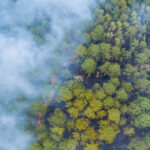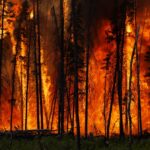Dr. Sujay Kaushal
By Wynne Anderson
Like many of the streams and rivers he studies, the source of Dr. Sujay Kaushal’s passion isn’t entirely obvious. Kaushal said he’s been interested in streams and rivers since his childhood in Tennessee, but has a deeper, cultural connection to them as well. His family comes from the Indian state of Punbaj, literally meaning “land of five rivers.” Today, he is an Assistant Professor in the Department of Geology at the University of Maryland and a scientist at ESSIC specializing in water resource research.
After Kaushal learned as an undergraduate student that he could actually study rivers and streams for a living, he went on to do his PhD at the University of Colorado, Boulder, an arid region where water resource studies are key. He studied mountain lakes and rivers to look for impacts from land use and development, and has since gone on to study such things as the long term impacts on urban ecosystems.
Kaushal’s studies today focus heavily on urban impacts on water sources in Baltimore, Washington, D.C., and the Chesapeake Bay region. People often may not realize that streams and rivers are actually drinking water sources, said Kaushal.
“We work on the Potomac River from where it comes out at Great Falls all the way up to where it comes in to the Bay,” he said. “Looking in the water is like looking in a mirror, we can use all of our research tools to see all of the human impact on the water.”
Kaushal works with different federal and local agencies, including the Washington, D.C. Water and Sewer authority and U.S. Geological Survey, to trace the containments in rivers like the Potomac or small streams in the Baltimore metropolitan area back to their sources. It’s almost like solving crime, he said.
“A lot of what we do is like being a detective. We’re trying to figure out where these chemicals come from, and so by using these geo-technical tools we can find out who the criminals are, where the pollution comes from.”
Kaushal and his colleagues aren’t always looking for pollutants in drinking water, but larger bodies of water as well. A large part of his work brings him to the Chesapeake Bay. While not many people associate the estuary with its surrounding streams and rivers, Kaushal uses data from these exact sources to trace the pollution going in to the Bay and its tributaries. If scientists are going to fix the problems in the Chesapeake Bay, he said, they must first make the connection between the watershed and what’s happening in the Bay itself.
While a new law in Maryland addresses fertilizer use to curb nitrogen runoff entering the Chesapeake Bay, Kaushal says that there are some emerging pollutants other than nitrogen such as organic containments, road salts, and other metals that need to be adequately managed. Emerging pollution trends like these create a bridge between Kaushal’s field work and his office work. He splits his time half and half between his geochemisty research and his work at ESSIC analyzing the water quality patterns.
“Right now, we are able to take what we can learn from what we’re doing right here on this chemistry bench and apply it to regional watershed models,” he said. “I could stay in the lab doing what I’m doing now, but the only way I could really understand what’s happening on a bigger scale is to have that other half in ESSIC.”
At ESSIC, Kaushal collaborates with other scientists to figure out what will happen in the future with water resources. Comparing his relationship with the water samples to that of a doctor and patient, he explains that at ESSIC they are looking to figure out the patient history, prognosis, and then hopefully treatment for the watershed areas.
“A lot of times in science it’s really easy to identify problems, but in this day and age it’s important that we present certain recommendations and solutions for these problems,” Kaushal said. He stressed his work at ESSIC as a way to work towards these solutions.
His work at both ESSIC and the Geology Department also caters to another passion of his: traveling out in the field. This past summer Kaushal went all the way to India to collect water samples from the source of the Ganges River at the Gangotri glacier in the Himilayas to see how human activities have altered the carbon and nitrogen cycles flowing downriver. Closer to home, he brings his six-week-old son along on boating and hiking expeditions to collect water samples on the Anacostia River.
“I’ve seen all kinds of places, I even spent some time in Germany working on Berlin’s drinking supply” said Kaushal. “What I really love is going out in the field. For me that’s really fun.”






